- Blog
- The Importance and Challenges of Listing Verification for Online Marketplaces
The Importance and Challenges of Listing Verification for Online Marketplaces
In the rapidly evolving digital marketplace, ensuring the authenticity of listings without discouraging genuine sellers is a challenging task. Today, we delve into the complexities of listing verification, the importance of minimizing friction for sellers, and the exploration of effective solutions like upstream identity verification, device fingerprinting, and tamper-resistant real-time location.
Subscribe to the Incognia Newsletter
The basic idea of P2P marketplaces is a great one—you have something, someone else wants it, you list it, they buy it, the platform benefits through a sales percentage or ad space, everyone leaves happy. As with many ways to make money on the Internet, however, fraudsters see online listings as a golden opportunity to make something for nothing. Whether it’s luxury goods, car rentals, or vacation housing, fraudsters can make a quick buck if they can fool consumers into paying for a fake listing on your platform. For listings that require an in-person interaction, like vacation home or car rentals, the risks can be even more severe.
That means that for the health of your marketplace to stay strong, listing verification is an absolute must. With many things fraud prevention, however, it may be easier said than done.
The risks of fake listings
The risks of fake listings vary based on the type of platform they’re posted on and the type of product or service offered, but they all spell bad news for someone committed to delivering a good user experience.
1. Trust & Safety concerns
Because many online marketplaces rely on connections between peers, there’s often an in-person meeting facilitated by online sales. For example, you might purchase a luxury bag online and want to meet the seller in person rather than risking such a high-ticket item getting lost in the mail. Some offerings have to be redeemed in person, like renting a vehicle or a short-term home rental.
If a vendor and their listing aren’t what they seem and a consumer agrees to meet up in person, the Trust & Safety risks are obvious. Users could be at risk of robbery or other physical violence, for instance. For vacation renters, the stakes might be even higher—people who just arrived in a new city with all of their luggage might be in a more vulnerable position than someone who goes to pick up a car or other product in their own city, for instance. These types of personal safety issues are the most severe potential consequence of a fake listing.
2. Reputational harm
When people respond to high-ticket listings like luxury goods, car rentals, or home rentals, they usually do so with the trust that the platform hosting that listing has done its due diligence in verifying sellers. When something goes wrong and consumers are faced with a scam or worse, an active safety concern, their trust in the brand takes a major hit. What’s more, unhappy consumers tend to talk about their experiences to warn others—and that negative word-of-mouth can have serious consequences for your user acquisition and retention.
3. Financial & customer retention losses
Along with loss of user trust and reputation also comes financial losses. No one wants to put their money into your platform after an experience where they’re defrauded or worse. Your platform might also take a hit in the form of settlements with affected customers in extreme cases. A widespread fake listing problem will see customers leaving your platform en masse, and that will mean less income for the business as a whole.
Challenges of effective listing verification
Naturally, most P2P marketplace style platforms already have some type of solutions in place to help combat fake listings, but, like all fraud prevention tools, these solutions face hurdles.
Why legacy database solutions are falling short
Using vacation rental platforms as an example, many of the leading apps use third-party address database solutions to verify the existence of a rental’s address and its connection to the host using the app. Unfortunately, these databases are far from the most reliable or most accurate solution on the market. As we’ve previously discussed here, address database solutions suffer from lack of coverage, lack of recency, and a lack of global scalability.
For global companies, subscriptions to different databases might be required for each individual country—some countries also don’t keep centralized address databases at all, meaning platforms will have to rely on private ones instead. Additionally, they might suffer from accuracy and recency problems, because how often they update their data is completely up to the database owners and not the platform using their services.
Lastly, databases can suffer from a lack of coverage. An individual might really own the house they’d like to list for rent, but gaps in the database’s knowledge could leave them unverifiable; for instance, an adult who isn’t listed in the DMV’s address database because they don’t have a driver’s license.
The importance of limiting friction for hosts and sellers verifying listings
Another perennial problem in listing verification is balancing friction for users with the security of new listings. The more checks your platform puts in place to verify listings, the less fake listings you’ll have but, there’s a chance it could mean less sellers and hosts, too. For instance, if you wanted to list a spare room for rent online, you might be tempted to give up and go to another platform if the first one you tried wanted three forms of ID verification and a scan of the deed to your house. Protecting the buyers’ experience is important, but there’s nothing to buy if friction-heavy design chases all of your sellers away.
Exploring signals & solutions for reliable listing verification
Even with all of this in mind, there are still ways to balance the scales and verify your users’ listings accurately.
Upstream identity verification
If your platform specializes in high-value items or services for rent or sale, putting some seller identity verification at onboarding can be a great way to weed out fraudsters upfront. Fraudsters treat their schemes like a business where time is money, but at the same time, they’re not usually looking to defraud good users under their real identity.
If someone wants to join your platform just to post a fake luxury bag or list a home for rent that doesn’t exist, they’re much less likely to follow through if their first big challenge is to provide a driver’s license photo or other documentation. Particularly dedicated fraudsters might use stolen or synthetic identity information to onboard anyways, but this significantly cuts their numbers by raising the entry level of resources needed to infiltrate the marketplace.
Device fingerprinting
Any account that posts fake listings will eventually be found out and dealt with after customers realize they’ve been scammed and start reporting the seller. Sellers keep up the momentum by having multiple accounts at their disposal, so that when one gets banned, they can switch to the next without losing any steam.
They do this by outfoxing device ID, either by using app cloning tools to make their one device look like many or by factory resetting their device to the same end. More persistent device fingerprinting (i.e., device fingerprinting that can detect tampering and resets and still identify the same device) can help ensure that banned users stay banned the first time. This ensures that even if someone manages to successfully post a fake listing, it’ll be the only chance they get.
Tamper-resistant, real-time location
For markets like the short-term rental market, tamper-resistant location is an excellent way to verify listings with minimal friction and minimal false positives. By checking that a host’s device is actually located inside the property they’re trying to list at the time they list it, your platform can have much more confidence in the host’s connection to that property in real life. Additionally, tamper-resistant location avoids the problems of weaker location-based solutions like lone GPS, meaning it can’t be spoofed with the use of apps or VPNs to present false location data to fraud prevention teams.
In one case study, Incognia was able to use our own tamper-resistant location technology to verify the addresses of 94.9% of onboarding users to a social media website, up from 70% verification with their previous, third-party powered solution. It’s clear that this type of sophisticated, real-time location can go a long way in boosting the confidence and trust of a location-based P2P app.
P2P marketplaces represent just a small slice of the peer connections the Internet is so good at creating. Though some people might want to take advantage of your platform to defraud your good users, there are just as many people creating solutions to help prevent that from happening. With the use of risk management techniques like upstream IDV and fraud prevention measures like real-time location and persistent device fingerprinting, you can create a safe, pleasant buying experience for your customers.




